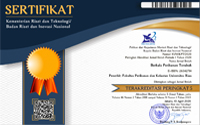MICROBIOLOGICAL TEST OF SQUID (Loligo sp.) WET NOODLES DURING STORAGE
Abstract
during storage. Microbiological testing of wet noodles was carried out with five kinds of tests, namely Total Plate Number (ALT), Most Probable Number (MPN), Test on Salmonella spp. bacteria, Test on S. aureus bacteria, and Yeast Mold Rates. This study used 3 (three) treatments and 5 replications. The results showed that storage time affected the microbiological quality of cooked squid wet noodles, where the quality of wet noodles could still last up to 24 hours of storage.
Keywords
Full Text:
PDFReferences
stria, N., Leksono, T., & Iriani, D. THE EFFECT OF DIFFERENT SALT CONCENTRATION ON THE QUALITY SALT-FERMENTED (PEDA) MACKEREL (Rastrelliger kanaguarta). Berkala Perikanan Terubuk, 48(3), 664676.
Azara, R., & Saidi, I. A. (2020). Buku Ajar Mikrobiologi Pangan. Umsida Press, 1-128.
Alcamo, I.E. (1983). Fundamentals of Microbiology. Addison-Wesley Publishing Company Inc., Massachusetts.
Chamdani (2005). Pemilihan Bahan Pengawet yang Sesuai pada Produk Mie Basah. Christensen, C. M. (1982). Storage of cereal grains and their products (No. 631.5 Ch555s). American Association of Cereal Chemists,.
Fardiaz, S. (1992). Mikrobiologi Pangan I. Jakarta. PT Gramedia Pustaka Utama.
Firdaus, R. A., Utami, R., & Nurhartadi, E. (2015). Aplikasi ekstrak abu sabut kelapa sebagai bahan pengenyal dan pengawet alami dalam pembuatan mie basah. Jurnal Teknologi Hasil Pertanian, 8(2), 99-106.
Frazier, W. C., & Westhoff, D. C. (1978). Food Microbiology 3rd Edition McGraw Hill Book company. New York, 540.
Hasfi Yuliana, H. Y. (2018). Perubahan Mutu Mikrobiologi, Kimia, Fisik Dan Organoleptik Mie Basah Tersubstitusi Sari
Mikrobiologi, Kimia, Fisik Dan Organoleptik Tersubstitusi Mocaf Dengan Penambahan air KI DAN Sari Kunyit Selama Penyimpanan Mikrobiologi, Kimia, Fisik Dan Organoleptik Mocaf Dengan Penambahan Air KIDAN (Doctoral dissertation, Universitas Mataram).
Himawati, E. (2010). Pengaruh penambahan asap cair tempurung kelapa destilasi dan redestilasi terhadap sifat kimia, mikrobiologi, dan sensoris ikan pindang Layang (Decapterus spp) selama penyimpanan.
Hoseney, R. C. (1998). Principles of cereal science and technology (pp. 321–334). St. Paul, MN: American Association of Cereal Chemists.
Ilmu, D., & Pangan, T. (2005). Perbaikan Mutu dan Umur Simpan Mie Basah di Indonesia. IPB. Bogor.(tidak dipublikasikan).
Jay, J. M. (2000). Modern food microbiology. 6th edit. An ASPEN Publication. Gaithersburg, Maryland.
Matz, S. A. (1965). Moisture transfer in finished products. Water in Foods. AVI Publishing Co., Inc.: Westport, CT.
Nurjanah, S. (2006). Kajian sumber cemaran mikrobiologis pangan pada beberapa rumah makan di lingkar kampus IPB
Darmaga, Bogor.
Pahrudin, (2005). Aplikasi bahan pengawet untuk memperpanjang umur simpan mie basah matang.
Ritantiyah, L. (2010). Di PT. Tiga Pilar Sejahtera Food, TBK Sragen–Indonesia.
Rosyadi, S. I., Afrianto, E., Rizal, A., & Pratama, R. I. ANALYSIS OF GOOD MANUFACTURING PRACTICE AT
HOME INDUSTRY FOR CATFISH FLOSS IN PURWOSARI, KEDIRI REGENCY. Berkala Perikanan Terubuk, 47(2), 126-133.
Salanggon, A. M., Hanifah., Tanod, W. A., & Hermawan, R. (2020). ALT Bakteri dan Kapang Mie Basah Daging Cumi
Cumi Dengan Lama Penyimpanan Berbeda. Kauderni: Journal of Fisheries, Marine and Aquatic Science, 2(1), 45-51.
Zhang, W., & Hoseney, R. C. (1998). Factors affecting expansion of corn meals with poor and good expansion
properties. Cereal chemistry, 75(5), 639-643
DOI: http://dx.doi.org/10.31258/terubuk.49.3.1148-1154
Refbacks
- There are currently no refbacks.
Copyright (c) 2021 Anita Treisya Aristawati, Finarti Finarti, Hanifah Hanifah, Alismi M Salanggon, Roni Hermawan

This work is licensed under a Creative Commons Attribution 4.0 International License.












